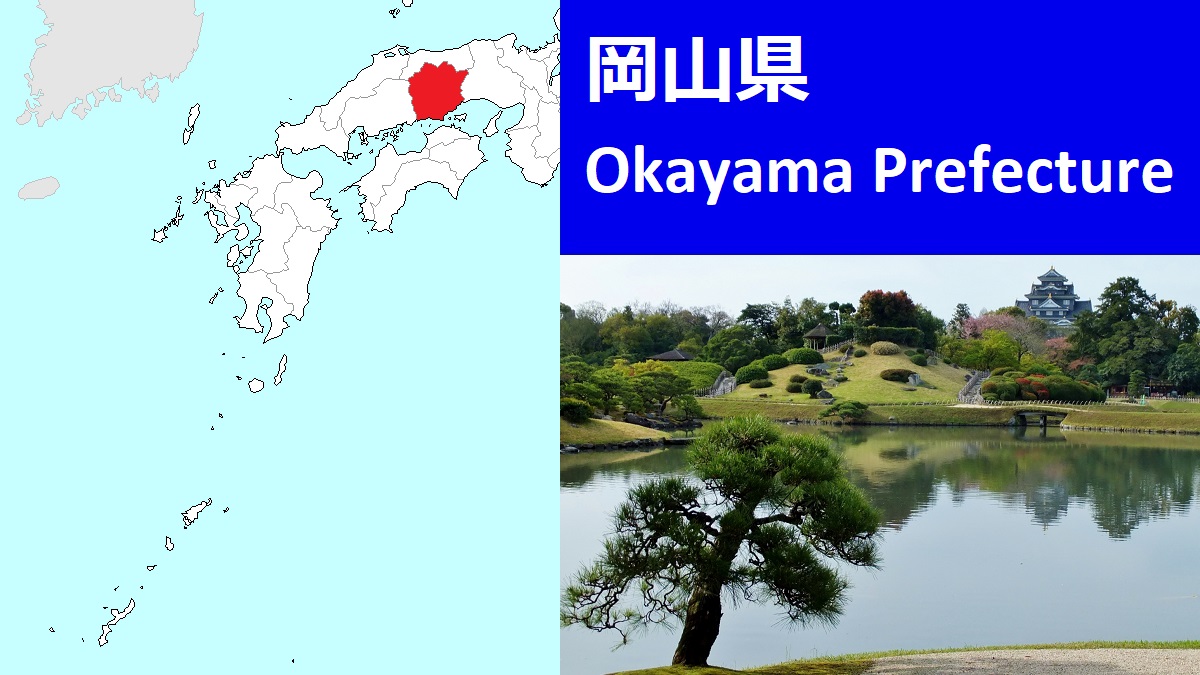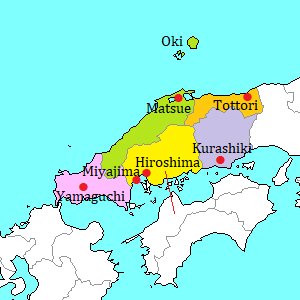Okayama Prefecture [岡山県]
Okayama Prefecture is located at the eastern part of Chugoku Region, and its south coast faces the Seto Inland Sea (Seto Naikai).
The area is nearly square, and the length of each side from east to west and from north to south is about 90 km.
The inland area is hilly, but there are not so high mountains.
Okayama Prefecture has the largest number of fine days per year in Japan.
So various vegetables and fruits have been caltivated.
Particularlly, muscat grape and white peach are the specialty products.
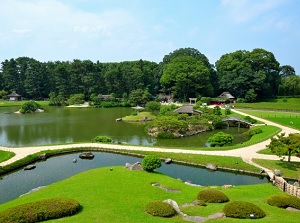
Korakuen garden
The prefectural capital is Okayama city, and is located at the center of the south coast.
It is the central city in the prefecture.
In addition, it is the important junction of railway in Chugoku District.
San-yo Shinkansen runs along the south coast.
The limited expresses to the main cities along the Sea of Japan in Chugoku Region leave from Okayama.
Also the limited expresses to the main cities in Shikoku Island leave from Okayama.
These trains cross the Great Seto Bridge (13.1 km) connecting Honshu Island and Shikoku Island.
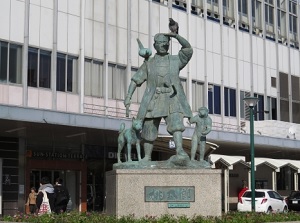
Statue of Momotaro in front of Okayama station
By the way, you will find a name "Momotaro" in Okayama Prefecure sometimes.
It is a famous fairy tale in connection with Okayama, and most Japanese children know the tale.
Momotaro is the name of a samurai boy.
He was born from a big peach floated down a river and was raised by an old man and his wife who found the peach.
When he became a strong boy, he was accompanied by a dog, a monkey and a Japanese pheasant and fought off bad ogre living in an island.
He defeating of the ogre and brought many treasures for his parents.
Because of the hero of Okayama, the name of "Momotaro" is used as the nickname of Okayama Airport, tourist information center, etc.
Tourist Attractions in Okayama Prefecture
Transportation
Railway
- To Okayama from Shin-Osaka : 50 to 70 minutes by Shinkansen.
- To Okayama from Tokyo : About 3.5 hours by Shinkansen.
- To Kurashiki from Okayama : About 16 minutes by JR local train.
Express bus
- To Okayama from Tokyo : about 9.5 - 10.5 hours. (Night bus)
- To Okayama from Osaka : about 3 hours.
Airport
Okayama airport is located about 15 km north of Okayama city.
It has the flights from Haneda (Tokyo) almost.
Main events in Okayama Prefecture
Saidaiji Eyou (3rd Saturday in February)
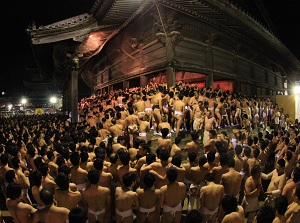
Photo : Okayama Prefectural Tourism Federation
Saidaiji is a Buddhist temple located about 12 km east of central Okayama city, and "Eyou" is the main festival of the temple.
The ceremonies are started three weeks before the main event, and a sacred wooden stick are made.
Then, for two weeks until the main event, many priests worship the stick in the temple.
On the day of the event, thousands of naked men with a loincloth come to the temple.
The chief priest throws the stick in the crowd, then the men jostle each other to get the stick.
The scene is dynamic, and the last man who has get the stick becomes the lucky man of the year.
Bitchu-Takahashi Matsuyama Dance (Early August)
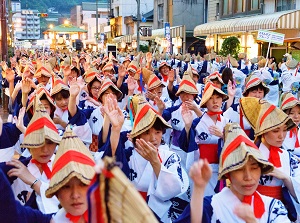
Photo : Okayama Prefectural Tourism Federation
It is a large Bon dance held in Takahashi city located about 40 km northwest of Okayama city.
"Bitchu" is the old name of the region and "Matsuyama" is the old name of the city.
The Bon festival was started in 1648.
It is said that the farmers danced for good harvests and prosperity.
Every year, tens of thousands people come to dance, and the scale is the biggest in Okayama Prefecture.
Local foods and products in Okayama Prefecture
Bara-zushi
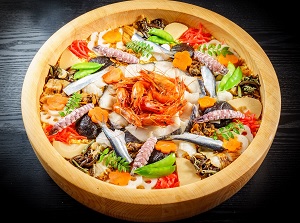
Photo : Okayama Prefectural Tourism Federation
Bara-zushi is the origin of "chirashi-zushi" which is a kind of sushi and is made by scattering various ingredients on vinegared rice in a bowl.
In the 17th century, Ikeda Mitsumasa (1609-1682), the lord of Okayama Castle, ordered that people had to eat only one dish and one soup as a meal for frugality.
Against this severe order, clever people made one dish containing various foods.
They mixed various chopped vegetables into vinegared rice, and topped a variety of fishes and the other foods on the rice.
"Chirashi-zushi" is mainly made at home, but Bara-zushi in Okayama is served in sushi restaurants and is gorgeous.
Muscat grape
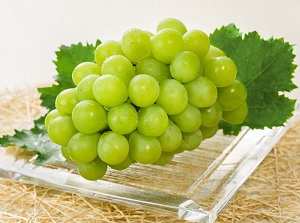
Photo : Okayama Prefectural Tourism Federation
Muscat is a kind of grape, and the cultivar is formally "Muscat of Alexandria".
It is one of the oldest genetically unmodified vines still in existence.
In Japan, it was cultivated in the 1880s for the first time.
But it took root in only Okayama Prefecture because of the suitable climate and soil.
Now Okayama Prefecture provides more than 90 percent of all production of muscat in Japan.
White peach
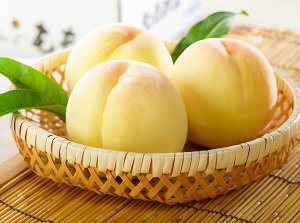
Photo : Okayama Prefectural Tourism Federation
White peach is one of the cultivar of peach, and was found incidentally in Okayama Prefecture in 1899.
The flesh is white, juicy and sweet.
The fruits is harvested in July and August.
Recently, it has been cultivated in several prefectures in Japan.
Okayama Prefecture accounts for about 40 percents of the Japan's white peach production.
Bizen Pottery
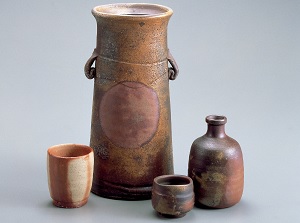
Photo : Okayama Prefectural Tourism Federation
Bizen Pottery ("Bizen-yaki" in Japanese) is the pottery produced around Bizen city located at the southeast part of Okayama Prefecture.
The production was started around the 12th century.
Bizen clay contains much iron content, so the pottery has reddish brown color.
The pottery uses no glaze, but has markings resulting from wood-burning kiln firing.
And it is hard like iron.

